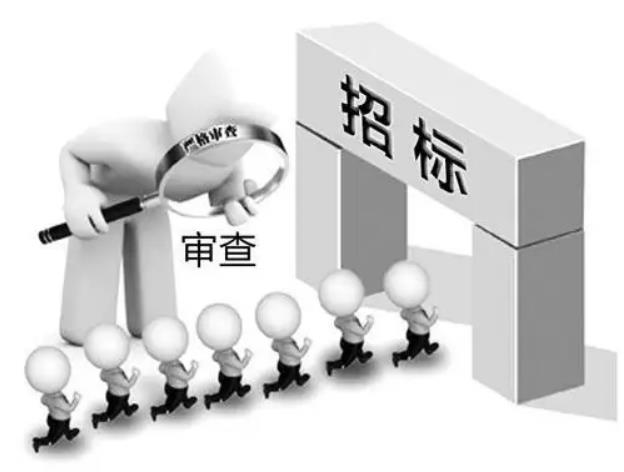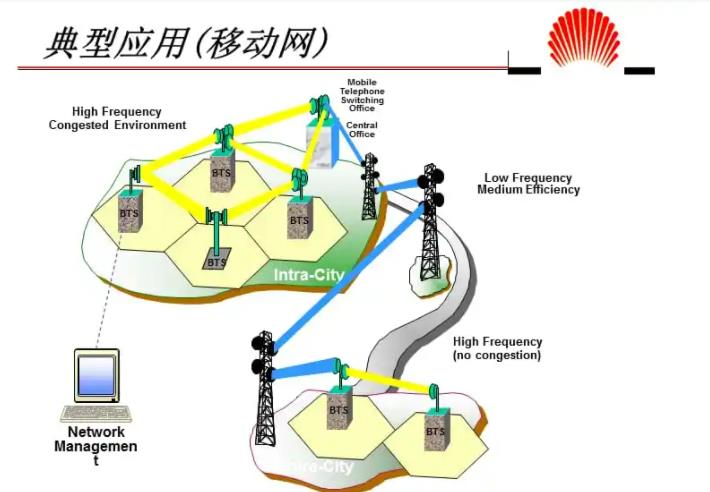实训项目二:分析涉外法律文书中的歧义
一、实训目标
通过实训,使学生理解何为涉外法律文书中的歧义,它包含哪些层面的意义,以及它涵盖哪些类型。通过实训,使学生能够通过仔细阅读涉外法律文书,发现隐藏在涉外法律文书中的歧义。通过实训,使学生能够运用多种方法尤其是图表的方法,来精确地分析涉外法律文书中的歧义。通过实训,使学生对于涉外法律文书中的歧义问题保持警觉,并始终处于积极发现问题、解决问题的良好状态,从而为制作较为优秀的涉外法律文书打下坚实的基础。
二、实训原理
法律文书中的歧义有广义和狭义之分。鲁珀特·克罗斯(Rupert Cross)在《法律解释》(Statutory Interpretation)一书中写道:“在日常语言里,歧义常常限于同一个词有两种不同意思的情况;而在法律解释、司法用语中可以使用‘歧义’这个词以表示词、短语或长一点法律条文的任何不明确的含义。”[7]当你在法律语境中——常常是在关于法律的评论里——见到“歧义”这个词时,它可以用来表示比平常所表示的意思更为广泛的含义。不过,在我们的讨论中,我们希望取其狭义,即同一个词有两种甚至两种以上的解释。
通常来讲,有三种不同类型的歧义,即句法的、语义的和语境的歧义。
句法歧义涉及词语前后的安排以及它们相互之间的关系。在多数情况下,这可归结为这样一个问题:“什么修饰什么?”美国法律文书起草泰斗里德·狄克森(Reed Dickerson)曾指出:“也许法律文件像其他文书一样,使用不明确的修饰语或参照物造成了最主要的意义不确定因素,这在技术上称为‘句法歧义’。”
语义歧义是指特定词语多种意义的某种不确定性。语义歧义是比较容易发现的。显然,你在字里行间看到一个词,这个词可能有两个意思,它就有歧义。
语境歧义是法律评论家提到的一种特殊类型的歧义,它关系到一份文件的内在一致性。也就是说,在一份文件中,某一条规定可能与另一条规定不一致,问题是,应以哪条规定为准?这就是语境歧义。语境歧义比句法歧义和语义歧义罕见。[8]
人们分析句子会使用许多不同的图解。本教程选择了五种最常用的,而且或许是最容易理解的图解,这些图解主要被用来作为分析工具,而不是作为起草文本的具体工具。这五种图解是:(1)线路图解;(2)括弧;(3)里德—凯洛格(Reed-Kellogg)图解(这是句子语法的标准图解);(4)句子短语树图解;(5)分段。介绍这五种图解,是为了展现在已经研究过的不同短语或句子中的种种显示歧义的形式。这些形式不一定都是同样有用的,但至少其中的一两项会让读者更好地了解歧义的性质。从不同角度研究一种现象,有助于帮助读者更好地看出歧义和更好地理解歧义。
(一)线路图解
线路图解是一种常用的分析英文文本中的歧义的方法,它看上去像电气线路,就好像电流从左边流向右边那样。
请看来自《美国克雷顿法案》(Clayton Act)中的一个例子:
“[Section 5(a)of the Clayton Act 15 U.S.C.§16(a)(1958)]provides that civil or criminal judgments won by the United States are prima facie evidence of the defendant's antitrust violation in any subsequent treble damages case against him. An exception is made,however,in order to encourage defendants to enter into consent decrees—‘...[t]his section shall not apply to consent judgments or decrees entered before any testimony has been taken ...’”
该句的前修饰语和后修饰语都有歧义。先看后修饰语。在图解(i)中,从左边开始,经过“consent”和“judgments”,到句子的其余部分。另一个选择是经过“decrees entered before any testimony has been taken”,到句子的其余部分。如果“entered before any testimony has been taken”这个短语对“judgments”和“decrees”都修饰,那就需要图解(ii)。
图解(iii)涉及前修饰语。这里的问题是,“consent”是否不仅修饰“judgments”,而且也修饰“decrees”?是“consent”—“judgments”和“consent”—“decrees”,还是“consent”—“judgments”然后“decrees”?一种解释是,它对两个都修饰,而后面的后修饰语“entered before any testimony has been taken”只修饰“decrees”。
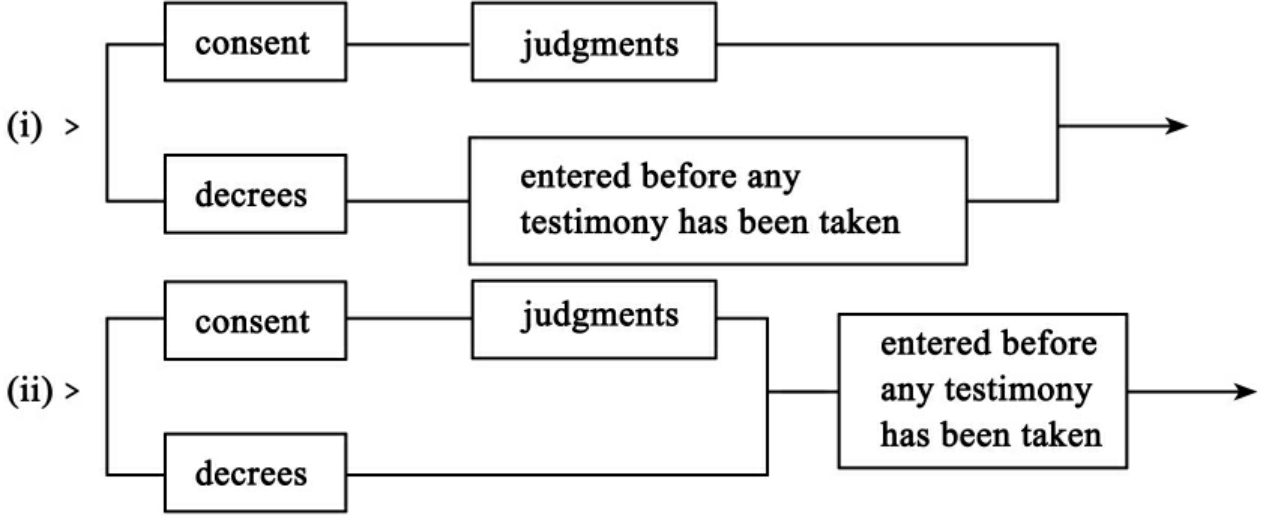
图解(iv)又是另一种解释,即后修饰语对“judgments”和“decrees”都修饰。这样一来,前修饰语和后修饰语就都修饰这两个名词,于是就有了四种,而不是两种选择。
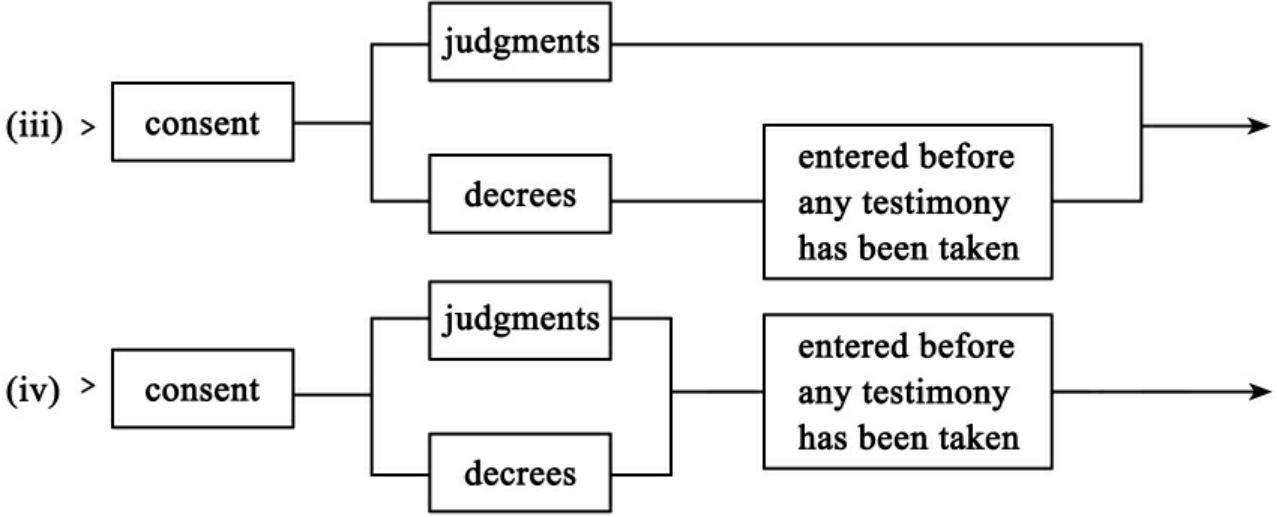
《克雷顿法案》的歧义有四种不同的意思。用英文可以表述如下:
(i)Decrees entered before any testimony has been taken and consent judgments.
(ii)Consent judgments entered before any testimony has been taken and decrees entered before any testimony has been taken.
(iii)Consent decrees entered before any testimony has been taken and consent judgments.
(iv)Consent judgments entered before any testimony has been taken and consent decrees entered before any testimony has been taken.
从上面的英文表述可以看出,在简洁与准确之间有某种妥协。《克雷顿法案》原来的文字非常简洁,但不十分准确。如果要把意思说得明确一些,就得多用词。这就是妥协——用的词多了,但意思清楚了。
(二)括弧
一份法令称:
“The council must publish a Swahili newspaper or magazine concerned with the Swahili language and African affairs.”
“concerned with the Swahili language and African affairs”这个短语是否不仅修饰“magazine”,而且也修饰“newspaper”?分析这个歧义的一个办法是用括弧,即在“magazine”前面加一个括弧,在句子最后再加一个括弧,如:
“The council must publish a Swahili newspaper or[magazine concerned with the Swahili language and African affairs].”
括弧表示“concerned with the Swahili language and African affairs”只修饰“magazine”。
如果把括弧放在“Swahili newspaper”前面,如:
“The council must publish a[Swahili newspaper or magazine concerned with the Swahili language and African affairs].”
这就表示这个短语修饰括弧里所有并列成分,包括“Swahili newspaper”。
(三)里德—凯洛格图解
里德—凯洛格图解是典型的句子图解。为便于分析,这里将引用与上节讨论括弧时相同的例句。
请看里德—凯洛格图解是如何显示后修饰语歧义的。
(1)
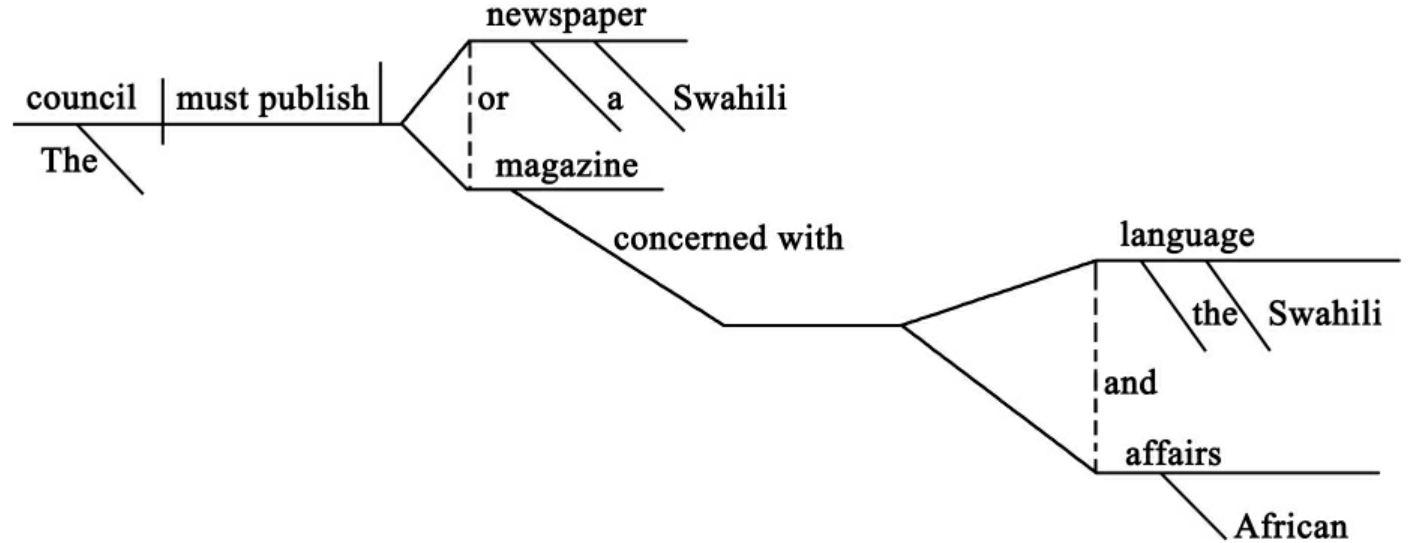
图解把句子分成三个基本部分。句子的主语在最左边,后面有一个隔断,之后就是主要动词。主要动词后面是宾语。主语和动词在一条构成句子主干的横线上,一条直线穿过横线把主语和动词隔开。动词结束时有一条垂直线,从横线向上延伸,它表示动词到此结束,宾语随后出现。句子从左到右,修饰语就放在它们所修饰的词下面的斜线上。所以,主语“the council”的“the”就在斜线上,主语后面是动词“must publish”,然后是宾语。这里有两个宾语——“newspaper”和“magazine”。宾语下面是修饰语,以“concerned with”开头,“with”是介词,后面还有两个宾语:一个是“language”,它有一个修饰语“the Swahili”;另一个是“affairs”,它的修饰语是“African”。
现在再来看图解(2)。
(2)
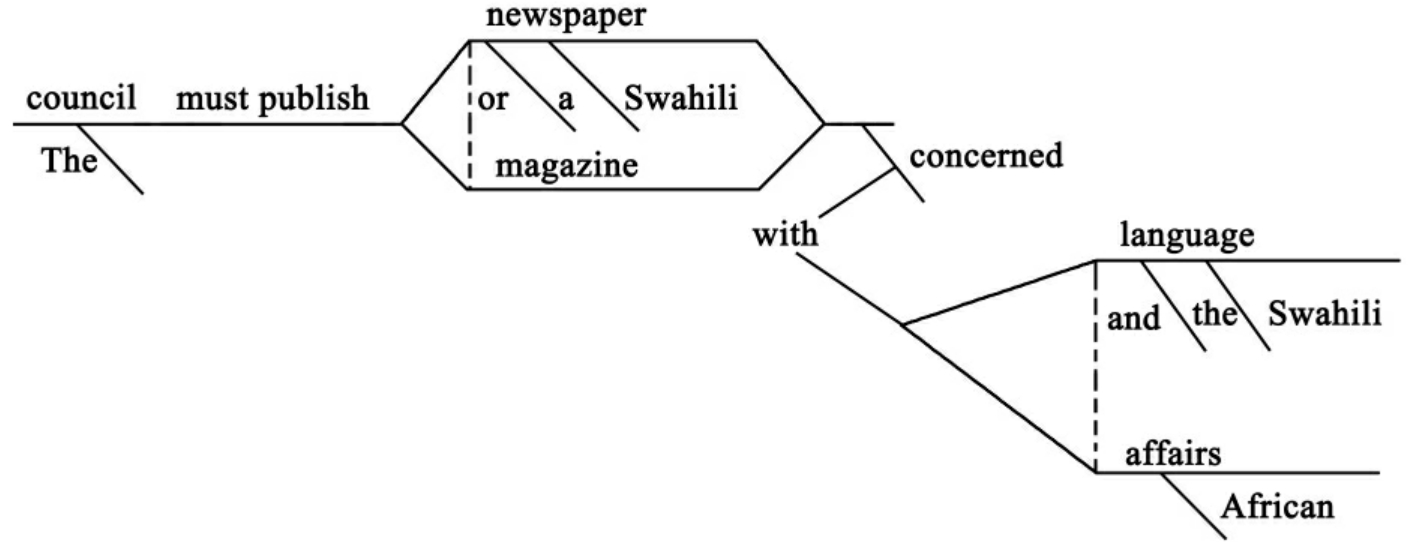
它与图解(1)相似,但又有所不同。“newspaper”在最上面,下面有“concerned with”,然后就是“the Swahili language and African affairs”,这就不同于图解(1),这里“concerned with”对“magazine”和“newspaper”都修饰,而图解(1)中,“concerned with”只修饰“magazine”。
里德—凯洛格图解可以清楚地显示修饰的范围,不过它需要画许多线,而且图表因此变得很庞大,多少显得有些笨拙。
(四)短语结构树图解
短语结构树图解主要为语言学家所采用。
这里我们也用前面见过的例子来说明:
“The council must publish a Swahili newspaper or magazine concerned with the Swahili language and African affairs.”
下面看看短语结构树图解是怎样显示后修饰语的歧义的。
(1)
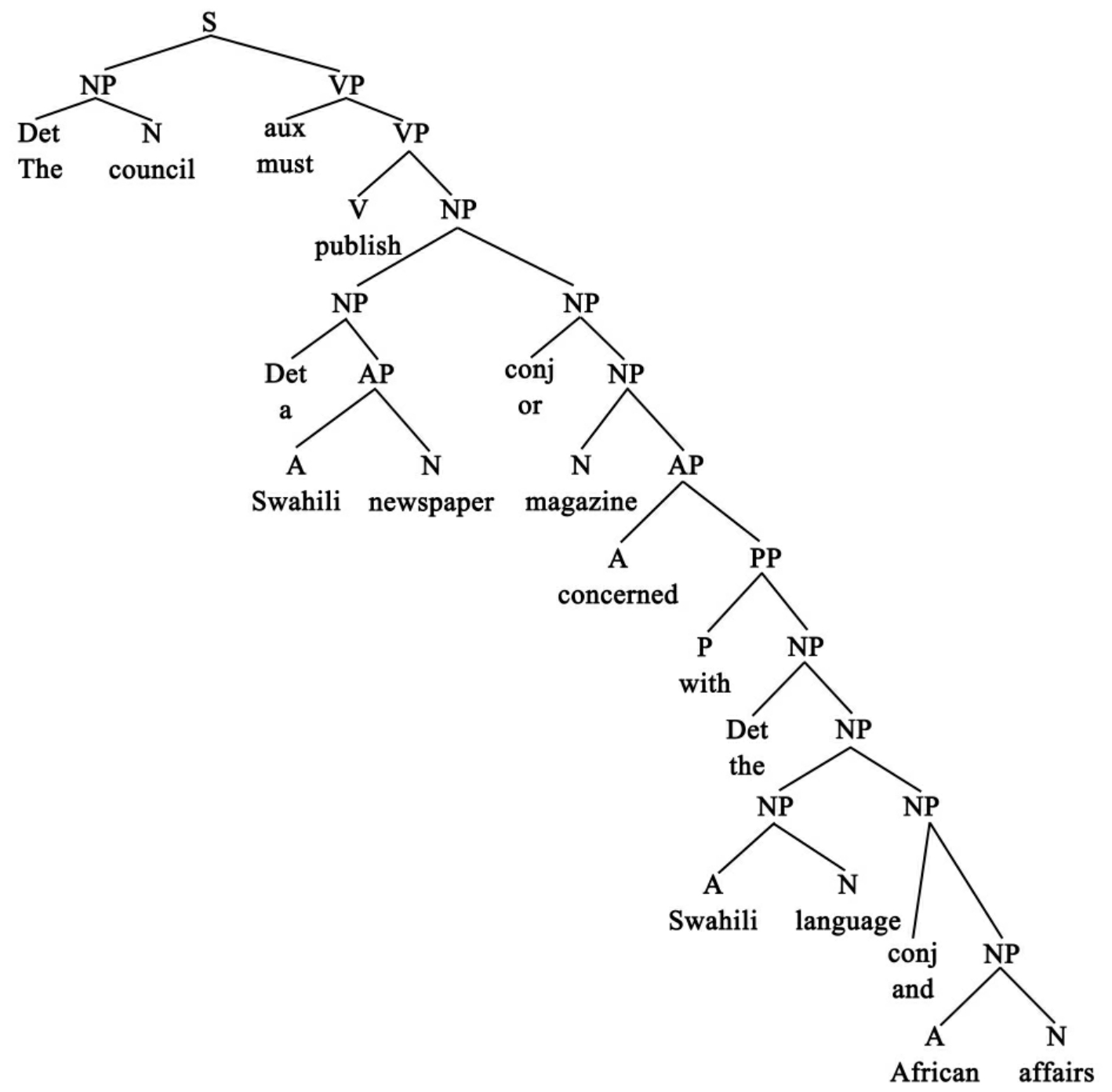
这里最高处的“S”代表“句子”,其左的“NP”代表“名词短语”,在“名词短语”里面或下面,“Det”代表“冠词”,“N”代表名词。再看最左面,有“The council”,然后从最高处的“S”往右走,有两个“VP”代表“动词短语”和一个“V”代表“动词”,再从“VP”往右走,有一个“NP”即“名词短语”。这个名词短语“a Swahili newspaper”有一个冠词,一个形容词和一个名词以及一个“conj”即“并列连词”。再往右是一个独立的名词短语“or magazine concerned with the Swahili language and African affairs”,它有一个名词和一个形容词短语,即“AP”。这个介词短语有一个形容词、一个介词和一个冠词“concerned with the”右面还有一个名词短语,那个名词短语有一个形容词“Swahili”,一个名词“language”,最后还有一个名词短语,它由一个形容词和一个名词组成,即“African affairs”。从图解中可以看出,“magazine”并不归到第一个名词短语“Swahili newspaper or”之下,而“concerned with”这个形容词短语只有一根线通到“magazine”,所以“concerned with the Swahili language and African affairs”这个短语只修饰“or magazine”,而不修饰“Swahili newspaper”。
图解(2)显示的情况有所不同。从句子的最高处往右到第一个名词短语(NP),然后再到下一个形容词短语(AP),你会注意到,那个名词短语有“magazine”,即“a Swahili newspaper or magazine”。这是第一个名词短语。这样,形容词短语就与那个名词短语直接联系起来,也就是说,整个修饰短语“concerned with the Swahili language and African affairs”就修饰包括“Swahili newspaper”在内的整个名词短语。
(2)
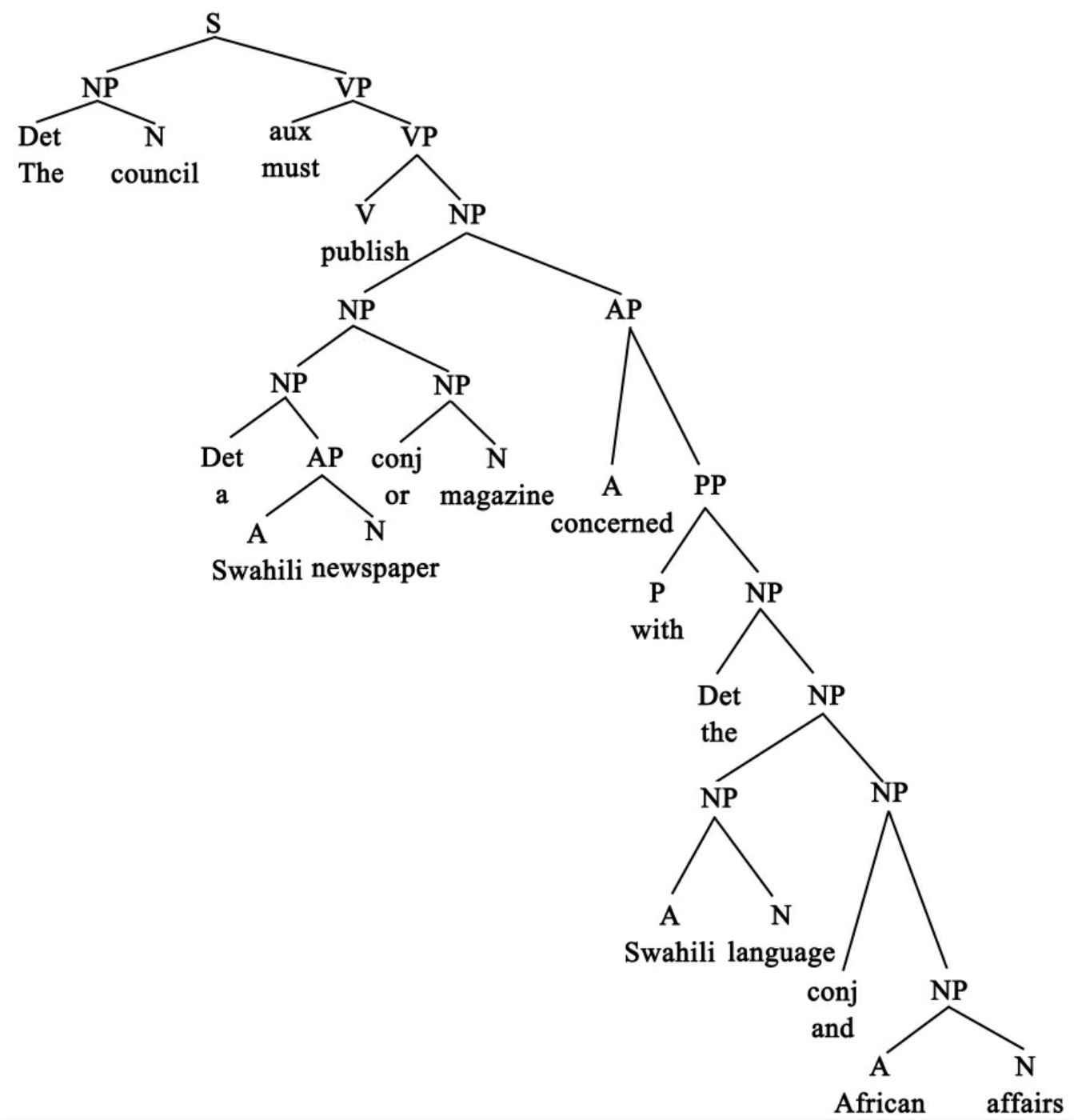
应该认为,短语结构树图解可以非常准确地显示这些不同的解释,不过你需要非常仔细地看这些线条,才能看出不同。所以,用这种方法分析歧义,对我们而言,作用也许是有限的。
(五)分段
“分段”是一个通用的名称,有人把它与“列表(tabulation)”区别开来,此外还有一种被称做“规范化(normalization)”的法律起草形式。上述形式在这里都统称为“分段”。
分段的优点在于,它不仅可以用来分析歧义,也可用于起草文件。分段的基本规则是:第一,如果后修饰语与前面紧靠的名词在同一段落(即缩行至同样程度),那么它只修饰前面紧靠的名词;第二,如果后修饰语与系列的最后一个并列成分不在同一段落(即不是缩行至同样程度),那么它修饰前面系列的所有名词。
请看一个来自《田纳西州关于转移精神病人的法案》的例子。
传统式的、未分段的文本是这样的:
“A person alleged to be of unsound mind found in this state,who has fled from another state,in which at the time of his flight,(a)he was under detention by law in a hospital,asylum,or other institution for the insane as a person of unsound mind;or(b)he had been heretofore determined by legal proceedings to be of unsound mind,the finding being unreversed and in full force and effect,and the control of his person having been acquired by a court of competent jurisdiction of the state from which he fled;or(c)he was subject to detention in such state,being then his legal domicile(personal service of process having been made)based on legal proceedings there pending to have him declared of unsound mind,shall,on demand of the executive authority of the state from which he fled,be delivered up to be removed thereto.”
这是一个相当复杂的句子。为了更好地理解它,使它的意思更清晰,该项法案可以被重新撰写成规范化文本。在规范化文本中,某些词,像“if”、“and”、“or”要大写,以显示它们是关键词。
加以分段之后的规范化文本如下:
“IF
(1)a person alleged to be of unsound mind is found in this state,AND
(2)the person has fled from another state,AND
(3)A.at the time of his flight from the other state he was under detentionby law in a hospital,asylum,or other institution for the insane as a person of unsound mind,OR
B.(i)at the time of his flight from the other state he had been heretofore determined by legal proceedings to be of unsound mind,AND
(ii)the finding was reversed and in full force and effect,AND
(iii)the control of his person has been acquired by a court of competent jurisdiction of the state from which he fled,OR
C.(i)at the time of his flight from the other state he was subject to detention in such state based on legal proceedings there pending to have him declared of unsound mind,AND
(ii)personal service of process was made on him there in those proceedings,AND
(iii)the other state was then his legal domicile,AND
(4)the executive authority of the state from which he fled has demanded he be delivered up to be removed,
THEN
(5)the person shall be delivered up to be removed to the other state.”
这种格式使文本更便于理解,更便于分析种种要求把精神病患者转移并交付到另一个州的因素。原来的文本有一些缺陷,使得该文本要难以理解一些。例如,“(personal service of process having been made)”的前后括弧使用不当,而且“domicile”后面应该有一个逗号。总之,规范化文本比传统式文本更显得“对读者友好”。
我们可以说,分段是用图解消除歧义的最好的办法。它表达的意思很清楚,而且容易实行。此外,分段不仅对分析有用,而且也可用于起草英文合同和其他法律文件;不仅对消除后修饰语的歧义有用,而且也可用于前修饰语。在多数情况下,分段十分有用,我们应该学会多使用它。当然,如果使用过度,则它会变得有点抽象和具有人工雕琢的味道。[9]
三、实训要求与过程
总的来说,实训要求学生理解何为涉外法律文书中的歧义,它包含哪些层面的意义,以及它涵盖哪些类型。实训要求学生能够通过仔细阅读涉外法律文书,发现隐藏在法律文书中的歧义。实训要求学生能够运用多种方法尤其线路图解、括弧、里德—凯洛格图解、句子短语树图解、分段等方式,来精确地分析涉外法律文书中的歧义。
就具体的实训步骤与过程来讲:首先,学生应当理解歧义的含义、歧义在涉外法律文书中的表现形式、歧义具有哪几个层面上的意义、歧义包括哪些类型等基本的问题。其次,学生应当养成仔细研读有关法律文书,注重发现歧义并予以处理的良好习惯。再次,学生应当逐步使自己有能力通过线路图解、括弧、里德—凯洛格图解、句子短语树图解、分段等方式,精确地分析涉外法律文书中的歧义。复次,学生应当培养自己综合运用上述手段,灵活分析特定语句的良好习惯,而不是僵硬地将上述手段适用到法律实务中去。最后,学生应当通过仔细分析歧义,思考歧义出现的原因,从而为更正歧义做准备。
四、实训材料
以下是一份由中国律师起草的房屋租赁合同的补充条款的英文本(节选),其中有不少的歧义,请找出至少5处歧义,分别运用线路图解、括弧、里德—凯洛格图解、句子短语树图解、分段等方式,对这些歧义予以解析。
Supplementary Clauses
1.Status of this Property to be Leased (omitted)
2.Users and Requirement (omitted)
3.Delivery Date and Lease Term (omitted)
4.Rental,Payment Manner and Term (omitted)
5.Payment Manner and Term of Property Management Fee and other Fees
(omitted)
6.Security Deposit and other Fees (omitted)
7.Property Utilization Requirement and Repair Obligation
Without prior written consent from Party A and the Property Management Company,Party B shall not,or allow other person to,conduct any re-construction,expansion or addition to this Property or its fit-out,auxiliary facility and equipment(including with no limitation to circuitry,water drainage,fire fighting,interior and exterior appearance and existing fitting-out).
With written consent from Party A and the Property Management Company and approval from the competent government authority,Party B may,as agreed by Party A and the Property Management Company to carry out reconstruction,expansion or addition to this Property and/or its fit-out,auxiliary facility and equipment.Fire fighting,air-conditioning system,management system and power facility as well as other fitting-out,expansion,addition and reconstruction that may influence central system and the general image of××××must be performed by the project contractor appointed by Party A or the Property Management Company,with respect to other fitting-out,expansion,addition and reconstruction,only the competent project contractor recognized by Party A may get engaged,Party B shall provide Party A with qualification certificate of such contractor.Party B and its engaged contractor have to comply with the“Commercial Property Decoration Guide”of××××and other rules and standards laid down by Party A and the Property Management Company regarding fitting-out and the amendment thereto from time to time.Party B shall be responsible for the repair and maintenance of the fitting-out,the expanded,added and reconstructed auxiliary facility and equipment hereunder,with respect to which,Party A accepts no responsibility for the repair and maintenance.
All the fees incurred under Clause 7.2 hereof,including the taxes and government charge shall be borne by Party B.
Party B shall be liable to maintain the interior part of this Property within the Lease Term and make this Property and its interior fitting-out,facility and equipment ready-to-use and available(except for natural wear-down).Any damage caused by the on-purpose activity or misconduct of Party B or its employee,contractor,supplier,as approved by Party A,shall be recovered within a reasonable time limit by qualified maintainer engaged by Party B.Should the recovery not be done within a reasonable time limit,Party A may repair in stead,yet Party B shall reimburse all the cost and expenses incurred to Party A due to such repair,otherwise,Party A is entitled to deduct such cost and expense from the Security Deposit.
8.Fitting-out
Within fifteen(15)days following the execution of this Contract,Party B shallsubmit application for fitting-out to Party A according to provisions under Commercial Property Decoration Guide and deliver the required data,design and detailed construction drawing of the interior fitting-out,equipment installation and furnishings of this Property to Party A for Party A and the Property Management Company's approval.The related construction can be carried out only after all necessary written consents or approvals from related governmental authorities are achieved by Party B on its own.
Party B shall pay the relevant fees to the Property Management Company according to the Commercial Property Decoration Guide and also be liable for payment of all the expenses arising from the submission for approval at governmental department in respect of the interior fitting-out,equipment installation and furnishings of this Property.
Should there be any inconsistency between the actual fitting-out by Party B and the foregoing drawings that have been approved by Party A in advance,Party A is entitled to request Party B to rectify its construction in accordance with the approved drawings,in addition,Party B is forbidden to open for business prior to the completion of such rectification,all the results and liabilities arising therefrom(including with no limitation to the additional fees incurred by the rectification or Party B's failure to complete fitting-out and open for business before the Fitting-out Period expires due to the delayed construction period caused by such rectification) shall all be assumed by Party B.
The interior fitting-out,equipment installation and furnishings of this Property that Party B carries out according to Clause 8 hereunder and the reconstruction,expansion or addition specified under Clause 7 hereof shall all comply with the Commercial Property Decoration Guide and other rules,standard or amendments thereto from time to time laid down by Party A and the Property Management Company.
Party B shall reimburse any damages of this Property or the Common Part of××××or other property leased by third party incurred from the decoration,expansion,reconstruction or maintenance by Party B.During the fitting-out term and term of expansion,reconstruction or maintenance,Party B shall not affect the normal operational activities of other tenants.
Before affixing any signboard,service indication,advertising or promotionClauses to this Property that are visible from the exterior of the same,Party B shall submit detailed figures to Party A and the Property Management Company in advance,and only make or display such figures at its own cost after achieving written approval from Party A and the Property Management Company.
Party B shall ensure its engaged contractor to insure the possible risks within the Fitting-out Period at its own cost with the insurance company before carrying out such fitting-out work to this Property,requirement for the insurance is set out in Clause 9 hereof.
Should Party B act against provisions of Clause 7 or 8 hereof,it shall be solely liable for all the result arising out of such default,including with no limitation to the burden of fees and expenses for rectification and dismantle required by relevant governmental authorities.Party B shall assume full liability of compensation for all the loss,claim,expense,litigation incurred to Party A due to its default.
Party A's review of,approval of or consent to the interior fitting-out,equipment installation and furnishings carried out by Party B's own to this Property according to provisions under Clause 8 and the reconstruction,expansion or addition carried out under Clause 7 hereof(including with no limitation to the written approval granted by Party A to Party B's design and construction drawings)shall not be deemed as that Party A would accept any liability for the fitting-out,equipment installation,furnishings,reconstruction,expansion or addition conducted by Party B.In the event that rectification,dismantle and/or any administrative penalty is required or imposed by relevant government authority,Party B must handle it on a timely basis and bear all the incurred fees and expenses,otherwise,Party A has the right to dissolve this Contract,should any liability,penalty,loss,claim,expense is incurred to Party A as a result of the same,Party B must reimburse to Party A in full.
Within the Lease Term,in case any competent government authority request for any rectification with respect to the interior fitting-out,equipment installation,furnishings,reconstruction,expansion or addition conducted by Party B to this Property,Party B shall notify Party A immediately and rectify accordingly as provided by law.In case any loss is caused to Party A or other tenants,Party B shall assume full liability.
Within the Lease Term,in case any competent government authority request for any rectification with respect to the interior fitting-out,equipment installation,furnishings,reconstruction,expansion or addition conducted by other tenants to this Property,Party B shall render necessary assistance and cooperation as required by Party A and the property management office,should any loss be caused to Party B due to the same,Party A shall assume the liability first,and then ask for reimburse from relevant tenant.
9.Insurance
The object of any insurance purchased by Party A regarding this Property shall be limited to this Property and the mechanic equipments or affixed facilities owned by Party A,and Party A shall be the beneficiary.In case that any insurance accident happens,all indemnities under such insurance policy hereof by relevant insurance company shall be owned by Party A.Party B has no right to request for sharing any insurance indemnity paid by the relevant insurance company and received and owned by Party A through claiming that its property losses or personal injuries are caused by such insurance accident.
During the Fitting-out Period,Party B or its project contractor shall,at its own costs and expenses,purchase construction all risks insurance(including third party liability insurance)in respect of the decoration of this Property from the insurance company recognized by Party A with the amount no less than RMB 1,000,000 and maintain it during the Fitting-out Period.The construction all risks(including third party liability insurance)shall satisfy the following conditions:
(1)Party A,Party B and the contractor shall be co-insured parties;
(2)The insurance period shall be in line with the Fitting-out Period;
(3)The insurance amount concerning the part of material loss in the insurance policy shall be sufficient to offset the loss amount;
(4)The insurance policy shall include public liability insurance,the amount of which shall be in compliance with the requirements of PRC laws;
(5)The insurance policy shall include the following special additional clauses:
(i)Cross liabilities clause;
(ii)Party A's property liability clause.
Prior to the commencement of decoration,as a necessary pre-condition,Party B shall provide Party A with the insurance policy specified in Clause 9.2 of these Supplementary Clauses hereof and voucher regarding the payment of premium. During the Fitting-out Period,Party A and the Property Management Company mayrequest Party B to provide the written certification to evidence the validity and compliance of requirement of the insurance purchased by Party B.
During the Lease Term,Party B shall affect the public liability insurance with respect to its business activities in this Property(with the amount no less than RMB 10 thousands)from the insurance company recognized by Party A,and maintain it during the Lease Term.The relevant insurance shall satisfy the following requirements:
(1)The co-insured party shall be Party A and Party B;
(2)The insurance period shall be in line with the Lease Term;
(3)The insurance amount shall comply with Party A's requirement;
(4)The insurance policy shall include the following special additional clauses:
(i)Fire and explosion clause;
(ii)Change of building clause;
(iii)Advertisement and ornament apparatus liability clause;
(iv)Personal injury liability clause;
(v)Loading and unloading of vehicle liability clause;
(vi)Cross liabilities clause;
(vii)Liability of the Landlord clause;
(viii)Waiver of subrogation clause.
Party B shall,within fifteen(15)days upon the Commencement Date,provide Party A with the insurance policy specified in Clause 9.4 of these Supplementary Clauses herein and document evidencing the valid existence of such insurance like the voucher of payment of premium.During the Lease Term,Party A and the Property Management Company may request Party B to provide the written certification to evidence the validity and compliance of requirement of the insurance purchased by Party B as well.
10.No Assignment
Without the written consent of Party A,Party B shall not be entitled to transfer,sub-lease or otherwise(including but not limited to underlet,permit,lend,share) this Property or any part thereof to any third party for use or occupation,regardless of payment of the rental or its equivalent in other forms by the third party.If Party B breaches this Clause hereof,Party A shall have the right to early terminate the Contract immediately and take back this Property.
In case that Party B establishes a new company at this Property as its registered address to engage in the business stipulated in Clause 2.1 of the Contract thereof,prior written consent of Party A shall be obtained.Within fifteen(15)days upon the establishment of the new company,Party B shall serve Party A the written notice therewith,and Party A shall cooperate to replace the tenant hereunder to the new company and complete relevant procedure regarding registration of lease contract. The relevant expenses and costs incurred therefrom shall be borne by Party B.After establishment of the new company all the rights and obligations of Party B are transferred to the new company as the parties agree hereby.If Party B provides Party A registered capital,corporate structure and any other information of the new company and thus can prove the well credit and ability for liability for the new company,Party A may then consider immuning the joint guarantee responsibility for Party B or charge some more guarantee deposit.
五、延伸思考与习题
1.什么是歧义?
2.歧义产生的原因是什么?
3.歧义有哪几种类型?
4.简述线路图解的歧义分析方式。
5.简述括弧的歧义分析方式。
6.简述里德—凯洛格图解的歧义分析方式。
7.简述句子短语树图解的歧义分析方式。
8.简述分段的歧义分析方式。
9.试比较线路图解、括弧、里德—凯洛格图解、句子短语树图解、分段等歧义分析方式的优劣。
10.请谈一谈在特定的法律文件中运用不同分析方式分析歧义的心得体会。
免责声明:以上内容源自网络,版权归原作者所有,如有侵犯您的原创版权请告知,我们将尽快删除相关内容。












